NST Getting Started: Difference between revisions
| Line 16: | Line 16: | ||
== Live Boot and Use == | == Live Boot and Use == | ||
When booting from your live media (DVD or USB stick), you should see a boot screen similar to the following: | |||
[[Image:nst20-live-boot-screen.png|thumb|center|NST 20 Live Boot]] | [[Image:nst20-live-boot-screen.png|thumb|center|NST 20 Live Boot]] | ||
If you don't press a key, the ''Graphical Desktop'' mode will boot by default. Use the arrow keys to choose one of the other modes (we recommend ''Console'' mode for systems with limited amounts of resources). | |||
== Live Boot and Install == | == Live Boot and Install == | ||
Revision as of 07:53, 29 January 2014
Create Boot Media
Download ISO Image
Prepare Boot Media
Burn ISO Image To DVD
Copy ISO Image to USB
Create Live USB Image
Boot
There are two ways to boot and use NST. A live boot, allows you to try out NST or use it for temporary rescue and analysis situations. A live boot has several limitations, but allows you to run NST without modifying your system. If you find NST to be useful, you will want to perform a full hard disk installation. Once installed to a hard disk, the NST will work like a typical Linux system - except that you will have a plethora of tools available to you through the comfort of your web browser.
Live Boot and Use
When booting from your live media (DVD or USB stick), you should see a boot screen similar to the following:
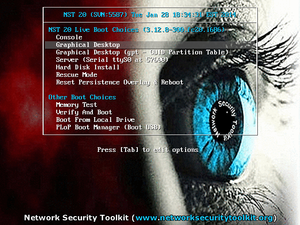
If you don't press a key, the Graphical Desktop mode will boot by default. Use the arrow keys to choose one of the other modes (we recommend Console mode for systems with limited amounts of resources).
Live Boot and Install
From the live boot screen, select the Hard Disk Install boot option. After a few moments (depending upon the speed of your hardware), you should be taken to the hard disk installation screen shown below.
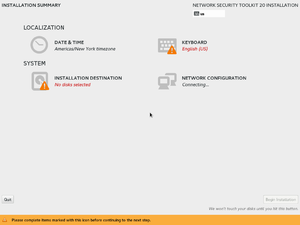
From this point, you should be able to proceed with the NST 20 Hard Disk Installation.
You do not need to boot directly to a hard disk installation. You can start a hard disk installation from a icon you find on the desktop or by using the nstliveinst script from the command line.
Hard Disk Boot
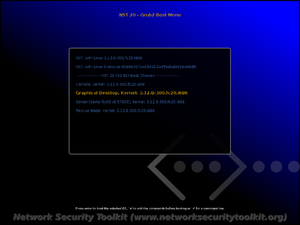
Log In
When booting in Graphical Desktop mode, you will see the following login screen:
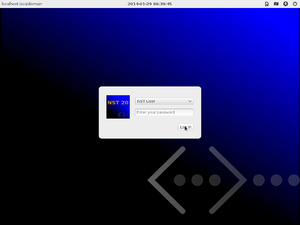
There is no password initially set, so you can simply click on the Log In button to log into the system.
Default Users/Passwords
The NST has two primary user accounts nst and root. You can log in using either of these accounts. Initially, these accounts do not have any passwords associated with them (just press the Enter key or leave the password field blank). Since the NST has no passwords set by default, both the sshd and httpd services are initially disabled. You will not have network access to your NST system out of the box.
Set Passwords
Before the NST system can be used on a network, you must set the passwords for the nst and root accounts. This is done by running the nstpasswd script. You can run this script at the command line, or you can select the Set NST Passwords icon on the desktop.
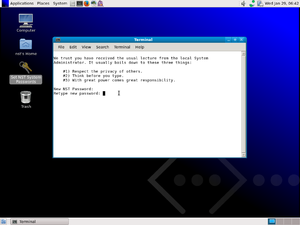
Running the nstpasswd script not only initializes the passwords for the user accounts missing passwords, it also enables the sshd and httpd services so you will be able to remotely access your NST system.
You only need to set the NST passwords one time after a hard disk installation. For live boots you will need to set the NST passwords every time you boot the system (unless you use a persistence layer).
Bring Up the NST Web User Interface
After setting the NST passwords
The main advantage of using NST comes from using its Web User Interface (WUI). The WUI provides a wealth of information and immediate access to many tools on the system. You can use the WUI locally on the NST system itself, or access it remotely using any other system on your network that has one of the major browsers (Chrome, Firefox, IE, etc).
To bring up the NST WUI on your NST system, click on the Firefox icon located near the top left of the screen.
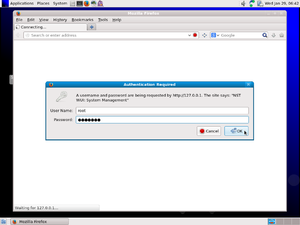
After successfully logging in, you should reach the main page. You will find a menu bar near the top of the page which allows you to quickly jump to many different tools.
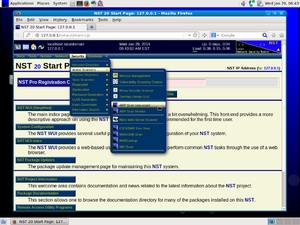
Explore
The NST is packed with a lot of tools and information (it can be a bit overwhelming). The following lists a set of tools that require a minimal amount of effort to get you started with.
- HowTo Use The NST WUI arp-scan Page To Quickly Locate Hosts
- Bandwidth Monitor
- Add other trivial tool links here